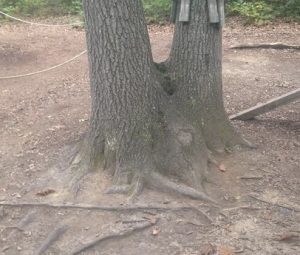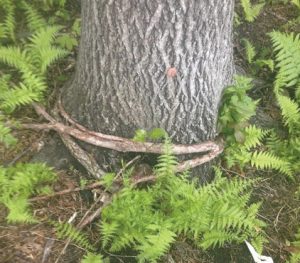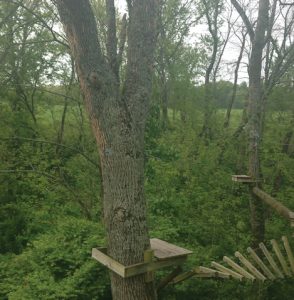Trees are amazing organisms that provide many benefits, including fantastic recreational opportunities to explore our natural world through adventure parks and challenge courses. So, it is our responsibility to give the trees we use for recreational pursuits the best environment for survival. In doing so, we can continue to enjoy, experience, and profit from these unique aerial adventure experiences.
The following outlines a basic tree inspection for adventure park and challenge course staff to periodically conduct, provides a few solutions to common tree health concerns, and offers guidance on when to have a professional arborist visit your park.
THE BASIC INSPECTION
We are all accustomed to inspecting our protective equipment, hardware, and cables before use, and likely more in depth each month. The trees we use for structural support should also be inspected periodically by the operations or maintenance staff, and annually by a professional arborist. Trees change slowly and have no recourse to quick changes in their environment. Regular inspection and wise care are essential to maintain their health.
The periodic in-house inspection should focus from the bottom up: the soil around the tree, roots, trunk, limbs, and branches.
SOIL
Trees are similar to icebergs. There is as much, possibly more, of a tree below the surface as there is above. The soil from which trees grow needs to be suitable. A basic tree inspection should examine the soil for changes in moisture and consistency.

Soil compaction from foot traffic can kill a tree over time.
Keep these questions in mind when inspecting the soil around your trees:
• Is the area experiencing a below or above normal rain year?
• Has erosion or soil compaction (the hardening of soil from foot traffic, machinery, or vehicles) occurred?
• Has the soil been disturbed for some other reason, such as a new retaining wall or pavement nearby?
• Are there mushrooms (fungi) growing in the soil around the tree? What kind are they? They may be associated with tree decay. An arborist will know the answers or where to find them. However, mushrooms may not be present when an arborist visits. Therefore, note the presence and type if at all possible. Clear photos are very helpful.
• Are roots rising from the ground? Has the soil began to rise on one side of the tree? These are indications of upheaving and are a serious indication of tree failure. Notify an arborist immediately.
All these soil events can affect a tree’s health. These events need to be observed and recorded (again, photos are useful) to help the arborist complete the picture of what is happening with the tree. The conditions may not be present or apparent when an arborist visits. The more detailed observations an adventure park operator or practitioner can make and record, the more effectively an arborist can diagnose concerns and prevent problems.
ROOTS

Girdling roots restrict flow of water through the tree.
The roots of trees are not easily visible. However, the root flare is. The flare is the bottom portion of the tree where the trunk begins to widen into segments, i.e. buttresses, before entering the soil. And the root flare can provide important information regarding a tree’s health and stability. The flare should be examined for damage, fungi growth, roots growing over one another—referred to as girdling roots—and digging from animals or insects. Also, make sure wood chips or mulch aren’t too deep around the root flare.
In addition, roots that grow close to the surface should also be inspected periodically. Have these roots been damaged by lawn equipment, foot traffic, or vandalism?
TRUNK
The trunk of a tree is the area before the limbs begin. Adventure park platforms are typically built on the trunk. It is the part of the tree responsible for transferring the weight of the tree and any built environment to the ground. The tree also uses the trunk to dampen forces such as wind and the loads adventure park and challenge course events apply to the tree.

Compartmentalized cavities (shown here) or cracks in trees leading to or near attachment points need to be assessed by an arborist.
The trunk needs to be inspected for new defects or changes to existing defects. These defects could include bark damage, cavities, insect or animal damage, vandalism, and pressure applied to the bark by any attachments such as cables, blocks, platforms, or any structural pieces.
Also, note whether there has been a change in cable tension. An unexplained or sudden change in cable tension can be an indicator that the tree is leaning or beginning to fail.
LIMBS AND BRANCHES
The periodic inspection of tree limbs and branches needs to consider two main objectives:
1. Structural issues that may negatively impact guests or staff in the near term. These include the usual suspects of dead limbs and branches, fungi on limbs or branches (lichen is normal and not alarming), a broken limb or partially separated branch, and sudden animal or insect activity.
2. Small changes that can signal a systemic problem or an infestation. They can also be indications of normal tree response to age or stress. This level of inspection may require a keen eye for change. Things to notice include: dieback at the twig level, leaf size, leaf color, insect browsing, and slow leaf-out in spring. These symptoms can signal a systemic problem or an infestation, but they can also indicate a normal tree response to age or stress.
COMMON PEST PROBLEMS
There are several common pest problems that affect trees used in adventure parks and challenge courses. Two are most noteworthy: insects that bore into trees, and insects that defoliate trees, i.e., eat all the leaves off.
The defoliating insects are typically caterpillars of various moths. The symptoms to watch for include leaf loss that begins with tiny holes in the leaf, the sound of caterpillar frass—debris or excrement produced by insects—falling to the ground, the presence of egg masses, and observed caterpillars in large numbers. There are methods to control these infestations, and a skilled arborist can lead you toward solutions that meet your budget and sensibilities.

This course was built in ash trees that were eventually killed by emerald ash borer beetles. The course had to close.
The boring insects are typically beetles, either native or introduced. Unfortunately, these insects can go undetected until it is too late, so it’s important to be aware of tree species that are affected by large-scale infestations in your area. For example, emerald ash borer beetles are destroying ash trees in the midwestern and eastern parts of the U.S. and some parts of Canada, and various pine beetles are damaging trees in most regions of North America. A skilled arborist or a county extension office can help educate you on which insects to watch for in your area.
COMMON HUMAN IMPACTS
We can sometimes love an area or activity to death, including our forest and other natural areas. Soil compaction can actually kill a tree over time, but symptoms can lag three to seven years behind the damage caused by compaction or soil grade change. If a problem is neglected for too long, it becomes very difficult to help the tree recover.
Traffic control. To avoid bringing this fate upon tree-based adventure parks or challenge courses, it is important to consider how guests, staff, and machinery move through the property. Common causes of soil compaction include foot traffic, machinery used during the construction phase, and maintenance vehicle traffic.
Keep your trees healthy by routing trails away from trees that are used for structural support. Build boardwalks to protect root zones and avoid soil compaction, and make sure congregation and picnic areas are adjacent to, not in the midst of, the trees being used to support structures.
Damage control. Two other common forms of damage to trees are bark damage and root damage, the latter of which can often occur during excavation. Consult an arborist if you plan to build anything near the trees being used to support structures, because tree roots are very sensitive to soil disruption. Bark damage can occur as your guests travel through the course or during the construction phase. Build protective bumpers and route cables away from trees to minimize damage to bark.
WHEN TO CALL AN ARBORIST
The recreational use of trees as we know it today is quite a young practice. We know very little about how, if at all, building in and moving between trees on cables or ropes affects tree structure. We certainly are just beginning to examine this question.
That’s why consulting with an International Society of Arboriculture arborist is important. And you should do so:
• once every 12 to 18 months for tree risk assessments of support trees;
• after major weather events that cause damage;
• anytime you see something abnormal with your trees.
Overall assessment. An arborist with Tree Risk Assessment qualification can help you assess the trees incorporated in your park or challenge course. This type of consultation costs money, so if budgets are tight, get creative to make it more affordable. For example, some arborists may be amicable to answer questions via email with photos about abnormalities, saving a site visit.
Maintenance. It is also very important to contact an arborist or tree care professional anytime hazards exceed the expertise of the staff available to perform the work. Pesticide application, too, may exceed staff expertise. Many states require pesticide applicator licenses to treat trees.
Design. Of course, you should involve an arborist in the design phase of a tree-based course. A skilled arborist can help you choose suitable trees and possibly help you avoid some costly mistakes. An arborist familiar with using trees as support structures can also help advise the best construction techniques for the tree species available at your site.






